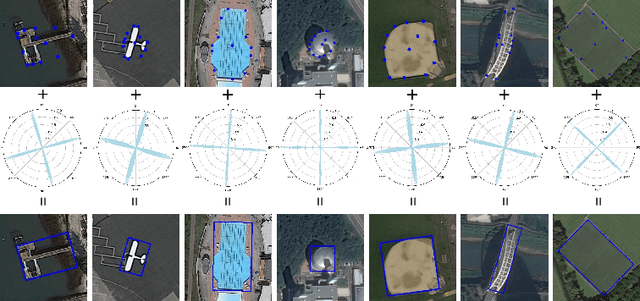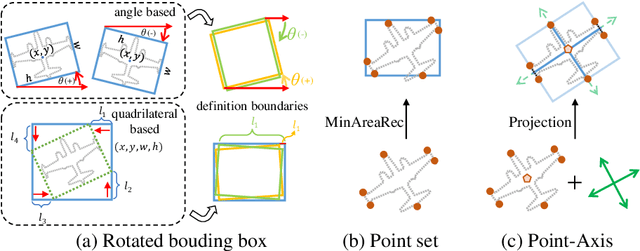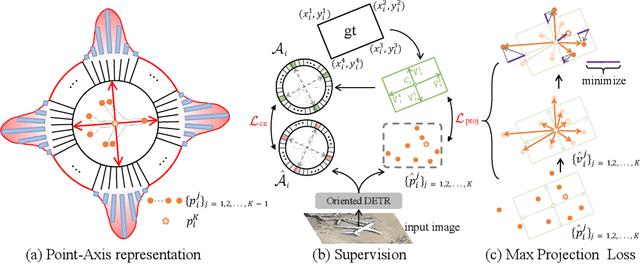Yihong Gong
Boosting Domain Incremental Learning: Selecting the Optimal Parameters is All You Need
May 29, 2025Abstract:Deep neural networks (DNNs) often underperform in real-world, dynamic settings where data distributions change over time. Domain Incremental Learning (DIL) offers a solution by enabling continual model adaptation, with Parameter-Isolation DIL (PIDIL) emerging as a promising paradigm to reduce knowledge conflicts. However, existing PIDIL methods struggle with parameter selection accuracy, especially as the number of domains and corresponding classes grows. To address this, we propose SOYO, a lightweight framework that improves domain selection in PIDIL. SOYO introduces a Gaussian Mixture Compressor (GMC) and Domain Feature Resampler (DFR) to store and balance prior domain data efficiently, while a Multi-level Domain Feature Fusion Network (MDFN) enhances domain feature extraction. Our framework supports multiple Parameter-Efficient Fine-Tuning (PEFT) methods and is validated across tasks such as image classification, object detection, and speech enhancement. Experimental results on six benchmarks demonstrate SOYO's consistent superiority over existing baselines, showcasing its robustness and adaptability in complex, evolving environments. The codes will be released in https://github.com/qwangcv/SOYO.
Beyond CLIP Generalization: Against Forward&Backward Forgetting Adapter for Continual Learning of Vision-Language Models
May 12, 2025Abstract:This study aims to address the problem of multi-domain task incremental learning~(MTIL), which requires that vision-language models~(VLMs) continuously acquire new knowledge while maintaining their inherent zero-shot recognition capability. Existing paradigms delegate the testing of unseen-domain samples to the original CLIP, which only prevents the degradation of the model's zero-shot capability but fails to enhance the generalization of the VLM further. To this end, we propose a novel MTIL framework, named AFA, which comprises two core modules: (1) an against forward-forgetting adapter that learns task-invariant information for each dataset in the incremental tasks to enhance the zero-shot recognition ability of VLMs; (2) an against backward-forgetting adapter that strengthens the few-shot learning capability of VLMs while supporting incremental learning. Extensive experiments demonstrate that the AFA method significantly outperforms existing state-of-the-art approaches, especially in few-shot MTIL tasks, and surpasses the inherent zero-shot performance of CLIP in terms of transferability. The code is provided in the Supplementary Material.
Learn by Reasoning: Analogical Weight Generation for Few-Shot Class-Incremental Learning
Mar 27, 2025Abstract:Few-shot class-incremental Learning (FSCIL) enables models to learn new classes from limited data while retaining performance on previously learned classes. Traditional FSCIL methods often require fine-tuning parameters with limited new class data and suffer from a separation between learning new classes and utilizing old knowledge. Inspired by the analogical learning mechanisms of the human brain, we propose a novel analogical generative method. Our approach includes the Brain-Inspired Analogical Generator (BiAG), which derives new class weights from existing classes without parameter fine-tuning during incremental stages. BiAG consists of three components: Weight Self-Attention Module (WSA), Weight & Prototype Analogical Attention Module (WPAA), and Semantic Conversion Module (SCM). SCM uses Neural Collapse theory for semantic conversion, WSA supplements new class weights, and WPAA computes analogies to generate new class weights. Experiments on miniImageNet, CUB-200, and CIFAR-100 datasets demonstrate that our method achieves higher final and average accuracy compared to SOTA methods.
Diversity Covariance-Aware Prompt Learning for Vision-Language Models
Mar 03, 2025Abstract:Prompt tuning can further enhance the performance of visual-language models across various downstream tasks (e.g., few-shot learning), enabling them to better adapt to specific applications and needs. In this paper, we present a Diversity Covariance-Aware framework that learns distributional information from the data to enhance the few-shot ability of the prompt model. First, we propose a covariance-aware method that models the covariance relationships between visual features and uses anisotropic Mahalanobis distance, instead of the suboptimal cosine distance, to measure the similarity between two modalities. We rigorously derive and prove the validity of this modeling process. Then, we propose the diversity-aware method, which learns multiple diverse soft prompts to capture different attributes of categories and aligns them independently with visual modalities. This method achieves multi-centered covariance modeling, leading to more diverse decision boundaries. Extensive experiments on 11 datasets in various tasks demonstrate the effectiveness of our method.
Space Rotation with Basis Transformation for Training-free Test-Time Adaptation
Feb 27, 2025Abstract:With the development of visual-language models (VLM) in downstream task applications, test-time adaptation methods based on VLM have attracted increasing attention for their ability to address changes distribution in test-time. Although prior approaches have achieved some progress, they typically either demand substantial computational resources or are constrained by the limitations of the original feature space, rendering them less effective for test-time adaptation tasks. To address these challenges, we propose a training-free feature space rotation with basis transformation for test-time adaptation. By leveraging the inherent distinctions among classes, we reconstruct the original feature space and map it to a new representation, thereby enhancing the clarity of class differences and providing more effective guidance for the model during testing. Additionally, to better capture relevant information from various classes, we maintain a dynamic queue to store representative samples. Experimental results across multiple benchmarks demonstrate that our method outperforms state-of-the-art techniques in terms of both performance and efficiency.
GridShow: Omni Visual Generation
Dec 17, 2024Abstract:In this paper, we introduce GRID, a novel paradigm that reframes a broad range of visual generation tasks as the problem of arranging grids, akin to film strips. At its core, GRID transforms temporal sequences into grid layouts, enabling image generation models to process visual sequences holistically. To achieve both layout consistency and motion coherence, we develop a parallel flow-matching training strategy that combines layout matching and temporal losses, guided by a coarse-to-fine schedule that evolves from basic layouts to precise motion control. Our approach demonstrates remarkable efficiency, achieving up to 35 faster inference speeds while using 1/1000 of the computational resources compared to specialized models. Extensive experiments show that GRID exhibits exceptional versatility across diverse visual generation tasks, from Text-to-Video to 3D Editing, while maintaining its foundational image generation capabilities. This dual strength in both expanded applications and preserved core competencies establishes GRID as an efficient and versatile omni-solution for visual generation.
LOBG:Less Overfitting for Better Generalization in Vision-Language Model
Oct 14, 2024Abstract:Existing prompt learning methods in Vision-Language Models (VLM) have effectively enhanced the transfer capability of VLM to downstream tasks, but they suffer from a significant decline in generalization due to severe overfitting. To address this issue, we propose a framework named LOBG for vision-language models. Specifically, we use CLIP to filter out fine-grained foreground information that might cause overfitting, thereby guiding prompts with basic visual concepts. To further mitigate overfitting, we devel oped a structural topology preservation (STP) loss at the feature level, which endows the feature space with overall plasticity, allowing effective reshaping of the feature space during optimization. Additionally, we employed hierarchical logit distilation (HLD) at the output level to constrain outputs, complementing STP at the output end. Extensive experimental results demonstrate that our method significantly improves generalization capability and alleviates overfitting compared to state-of-the-art approaches.
Prompt-Agnostic Adversarial Perturbation for Customized Diffusion Models
Aug 20, 2024



Abstract:Diffusion models have revolutionized customized text-to-image generation, allowing for efficient synthesis of photos from personal data with textual descriptions. However, these advancements bring forth risks including privacy breaches and unauthorized replication of artworks. Previous researches primarily center around using prompt-specific methods to generate adversarial examples to protect personal images, yet the effectiveness of existing methods is hindered by constrained adaptability to different prompts. In this paper, we introduce a Prompt-Agnostic Adversarial Perturbation (PAP) method for customized diffusion models. PAP first models the prompt distribution using a Laplace Approximation, and then produces prompt-agnostic perturbations by maximizing a disturbance expectation based on the modeled distribution. This approach effectively tackles the prompt-agnostic attacks, leading to improved defense stability. Extensive experiments in face privacy and artistic style protection, demonstrate the superior generalization of our method in comparison to existing techniques.
Beyond Prompt Learning: Continual Adapter for Efficient Rehearsal-Free Continual Learning
Jul 14, 2024



Abstract:The problem of Rehearsal-Free Continual Learning (RFCL) aims to continually learn new knowledge while preventing forgetting of the old knowledge, without storing any old samples and prototypes. The latest methods leverage large-scale pre-trained models as the backbone and use key-query matching to generate trainable prompts to learn new knowledge. However, the domain gap between the pre-training dataset and the downstream datasets can easily lead to inaccuracies in key-query matching prompt selection when directly generating queries using the pre-trained model, which hampers learning new knowledge. Thus, in this paper, we propose a beyond prompt learning approach to the RFCL task, called Continual Adapter (C-ADA). It mainly comprises a parameter-extensible continual adapter layer (CAL) and a scaling and shifting (S&S) module in parallel with the pre-trained model. C-ADA flexibly extends specific weights in CAL to learn new knowledge for each task and freezes old weights to preserve prior knowledge, thereby avoiding matching errors and operational inefficiencies introduced by key-query matching. To reduce the gap, C-ADA employs an S&S module to transfer the feature space from pre-trained datasets to downstream datasets. Moreover, we propose an orthogonal loss to mitigate the interaction between old and new knowledge. Our approach achieves significantly improved performance and training speed, outperforming the current state-of-the-art (SOTA) method. Additionally, we conduct experiments on domain-incremental learning, surpassing the SOTA, and demonstrating the generality of our approach in different settings.
Projecting Points to Axes: Oriented Object Detection via Point-Axis Representation
Jul 11, 2024



Abstract:This paper introduces the point-axis representation for oriented object detection, emphasizing its flexibility and geometrically intuitive nature with two key components: points and axes. 1) Points delineate the spatial extent and contours of objects, providing detailed shape descriptions. 2) Axes define the primary directionalities of objects, providing essential orientation cues crucial for precise detection. The point-axis representation decouples location and rotation, addressing the loss discontinuity issues commonly encountered in traditional bounding box-based approaches. For effective optimization without introducing additional annotations, we propose the max-projection loss to supervise point set learning and the cross-axis loss for robust axis representation learning. Further, leveraging this representation, we present the Oriented DETR model, seamlessly integrating the DETR framework for precise point-axis prediction and end-to-end detection. Experimental results demonstrate significant performance improvements in oriented object detection tasks.
 Add to Chrome
Add to Chrome Add to Firefox
Add to Firefox Add to Edge
Add to Edge